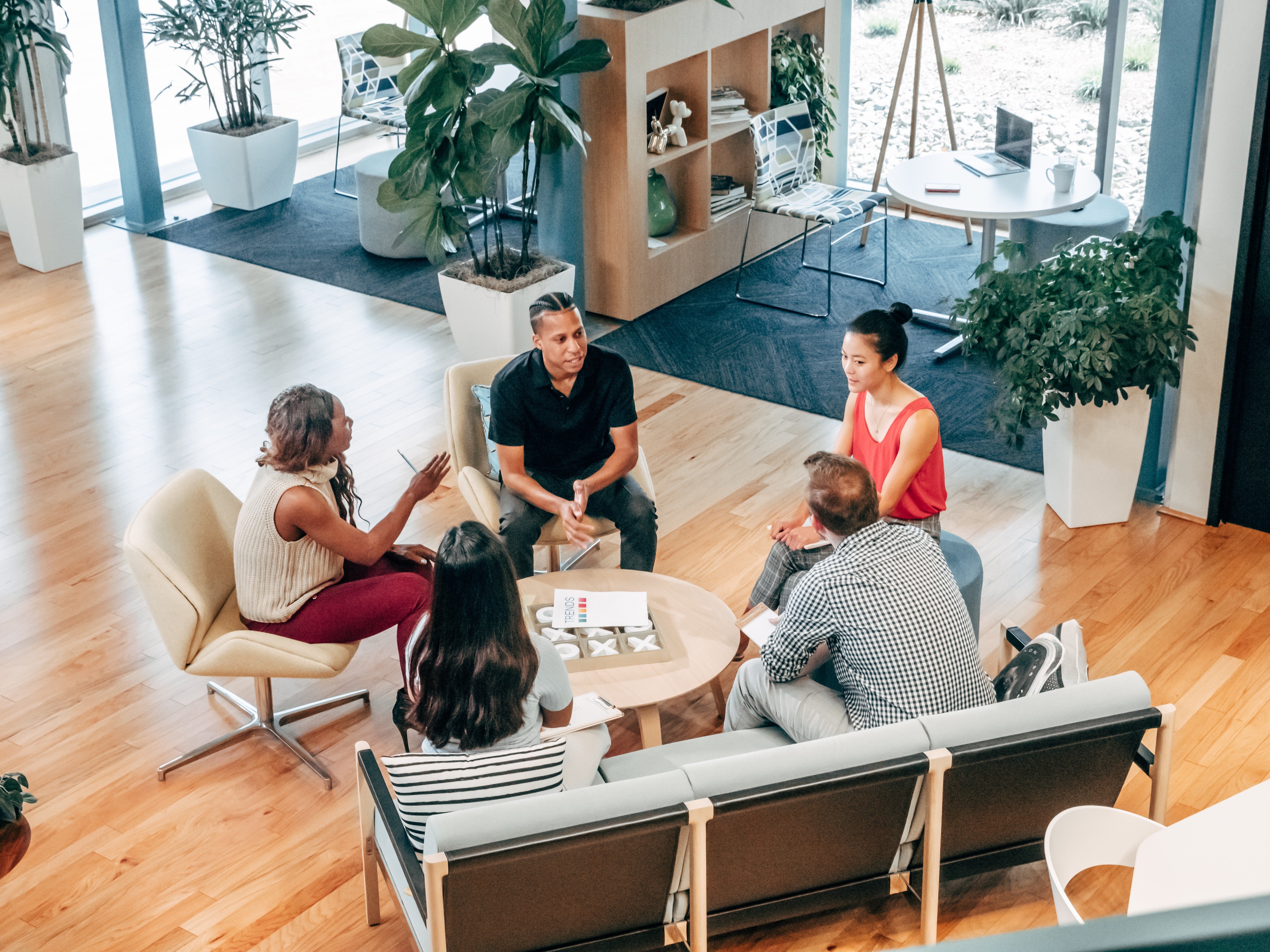
Workplace behaviors of the future are still emerging.
We must maintain flexibility, states Integri CEO, Robert Teed. Flexibility will be fundamental to the approach going forward as new circumstances will continue to emerge post Covid-19. His advice for adapting to the new workplace - be prepared to experiment and be flexible to achieve desired results.
The future of work has arrived. Here’s how to make it work for you.
Overview
As CEO of the Integri Group, Robert Teed combines 3 decades of experience in corporate real estate as a workplace executive, with expertise in supporting diverse organizations and individuals in transitioning to new ways of working.
The last 2 years have clearly been very different than what went before, but Teed sees the pandemic as a catalyst to existing trends and shifts in workplace strategy, which were already accelerating choice and flexibility for employees.
“Enterprises and corporate real estate executives were already looking for more flexibility in their portfolios… And workplace strategy has changed pretty dramatically, as we think about employees working in a much more distributed way,” he explained.
New challenges create new opportunities
The unknown unknowns of the present state of flux create uncertainties, which many workplaces are struggling to address strategically. As Teed points out, you can do as much scenario planning as you like, but without data on the way people behave in changed circumstances, it’s all so much speculation.
“We’re still missing what the employee behaviors are going to be. We haven’t brought knowledge workers back into the workplace en masse yet, so we’re missing those behaviors,” he explained.
However, this very uncertainty creates the potential, to shake things up and make improvements. “So we have an opportunity to experiment and make sure we’re creating the right experience for employees, as we look at our next way of working. It’s a challenge and an opportunity, that as the workplace business we need to be embracing.”
Caring for the people at the heart of change
All these shifts need to take place in the context of greater awareness of human needs, during these unprecedentedly stressful times.
“The needs of the employees in enterprise IT, they've changed in many ways towards caring, and really focusing on the employee well-being as central to everything,” Teed stated.
Again, this is an extension of an existing trend: ”This was happening as well before the pandemic. But as we moved into this pandemic environment, it became all about how do we care for the employees? How do we keep them safe? How do we keep them productive and engaged in this work from home environment?”
Like so many pandemic-driven shifts, this one is also going to stick, according to Teed - because you don’t simply roll back on the well-being aspects of HR. “This attention on the employee in a hyper-focused way is relatively new. And I think that's something that will continue as we move into our next way of working as well.”
The focus on the individual and what is best for them is rooted in the choices they now face, and trying to align workplace offerings with user expectations - a moving target for employers in the ‘new normality', as Teed reflected:
“Employees now own the choice of where they do their knowledge work, and the real estate trends this is showing up, are how do we get closer to the employee, where they live, where they reside? How do we bring work to them - because many of them aren’t going to want to continue to work from home all the time, they may want to work in some sort of an office environment.”
This change of decision-making locus has fundamentally altered the way we plan commercial real estate in a lasting way. “The formulas that we would have used pre-pandemic to design our workplace strategy, or real estate strategy or portfolio strategy, many of those sorts of metrics and formulas and rules of thumb aren't going to apply going forward.
“The key drivers are really that the employee piece has changed - where they work, when they work, how they work. And our portfolios have to be prepared to respond to that.”
CEO and Founder of Integri Group

Redefining the workplace for a flexible future
Flexibility will be fundamental, to creating an effective response in emergent circumstances.
“As we look at company offices, the way employees are going to be using them may be quite different, there’s probably going to be a lot less head-down work happening, and a lot less frequency of on-site work happening. So, those are all trends that we're having to think about from a workplace strategy and market trends perspective,” Teed explained.
It all comes back to those unknown behaviors - and the COVID era has certainly proven the sheer unpredictability of groups of people in the face of new situations, as many policymakers have found to their cost.
Technology and the changing ways we deploy it will also impact on the way we work, as employees bring those new skills and changed expectations back into the shared workplace with them. “New thinking needs to show up certainly around technology, and how we enable employees in this multimodal distributed way of working, and what are the things that they need to be engaged and productive and effective, regardless of where they're working. Technology can play a massive role in that, no matter where you are, so that technology layer becomes really important.” he pointed out.
Uncertainty creates risk
Consultants like Integri Group will be seeking to research and profile how people actually respond in the real world, rather than what businesses expect them to do.
“The risks we foresee are around not having clarity on those employee behaviors yet. So, I think before we rush out and make a lot of concrete decisions on reducing portfolios or increasing them, or highly distributing them, we do have to make sure that we're very clear on how employees are going to work. We need to measure employee behaviors and how they want to use the workplace,” Teed pointed out.
Furthermore, there is not yet any sense of settling into permanent new patterns, as public health data remains unpredictable - and as such, any conclusions drawn presently need to be regarded in that context, of ongoing flux. “Much of the survey data we’ve gathered over the past 18 months has been in the middle of a pandemic. It’s really powerful data, but until we see how behaviors show up, and how employees really do start to use our workplace or how they work, I think we have to make sure we're leaving a lot of room for flexibility and experimentation, and then pivot capabilities as well.”
New benefits for a changed world
In the ‘before’ days, permission to work remotely was often regarded as a sought-after perk. Today it is the new normality, so going forward Teed sees it as more important to focus on equity and a level playing field - as we craft new hybrid and flexible work styles, and ensure that no one is disadvantaged by the choices they make about where work is done.
“No matter where you're doing your work, you need to be equally enabled... We're making sure that employees are empowered, enabled in many different modes, and so that that's a benefit if you will.” Location bias will require active work to mitigate, to make distribute working both fair and effective.
This will include the ways we collaborate synchronously, for example in hybrid meetings. “There are some companies that have embraced the idea that all meetings will be virtual, even if folks are in the same room, and that levels the playing field. So everybody in the meeting is on video.
“I've also seen companies really focus on trying to level the playing field in a hybrid way, some in the room, some outside of the room - I think more important than the technology or the medium is, are really the folks that are running those meetings that are leading the meetings and being well aware. And in strong facilitators, in recognizing that we need to bring voices out of those that are on video and those that are in the room.”
Having the right tools in place will be necessary to support this, but ultimately it’s a management skill shift which will be needed to make this work. “That's not a technology solve. That's really a development opportunity for leaders, team leaders, facilitators, etc., to make sure that we're really bringing inclusivity and belonging to the forefront in any of these mixed-mode meetings.”
People who feel included will find it easier to feel good generally, and Teed pointed out that the awareness of holistic well-being will surely become a key differentiator, as so many sectors enter recruitment and retention crises, and have to compete for talent which has developed greater awareness of personal worth.
“I think that we've learned an awful lot around mental health in the workplace. And for companies and enterprises, really focusing on how they can contribute to the positive mental health of employees has become really important.”
It is important for Teed that we don’t lose sight of the upside gained from working together through the global crisis within our teams and organizations and take these connections with us into the future of work.
“I certainly don't want to lose sight of diversity, belonging, inclusion, some of the things that we've really struggled with before the pandemic, we've learned a lot about over the last two years, and we have to remain focused on this as we move into our next way of working.
“So that's not a benefit. That's foundational. That's an absolute requirement. But those are things that we don't want to lose sight of as we move into our next way of working.”
These shifts will enable top employers to retain the right people, and offer them fulfilling work experiences, whatever the future holds.
“We have to really focus on attracting new talent, retaining talent, and that's with this understanding that choice and flexibility is now in the hands of the employee. We have to recognize that we have to do that in a way where our culture still flows throughout this distributed workforce.”
And Teed concludes on the point that this will not mean instant savings, as enterprises reduce real estate footprint.
“As we think about cost savings, I would caution anybody who thinks that there's going to be a lot of cost savings associated with our next way of working in particular, around real estate savings.
“There will probably be some [savings] because there'll be repositioning of portfolios. But I think a lot of those savings will be reinvested in how we enable our distributed workforce, how we train leaders, how we leverage technology. So while expenditure may move from the real estate line item, they don't necessarily go away. They get redeployed elsewhere.”
Finally, being realistic about expectations and uncertainties will be key to success in the still-evolving future of work.
“I would just encourage everyone to allow for some patience, and some experimentation until we know what the employee behaviors are going to be. ... if we rush too quickly to implement concrete solutions, we may not get it right.
“Let's allow ourselves this opportunity to experiment, to be flexible, and to really get our next way of working right,” was Teed’s final recommendation, for adapting to the new reality of the workplace.
For more advice on how to develop a hybrid workplace strategy that works for your business, contact us or visit LiquidSpace.com/EnterpriseSolutions.
Ready to continue your journey?
There are two great ways to do it.
Ready to continue your journey?
There are two great ways to do it.






